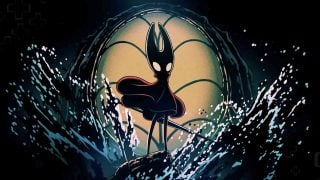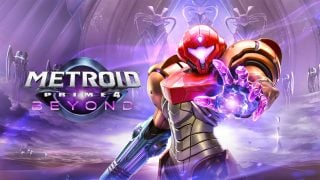In my eyes there are three multiplayer kings in the world of Nintendo. You have the crossover clobbering of Super Smash Bros., the fast-paced races of Mario Kart, and then there’s the dice rolling, luck cursing, Star gathering spectacular that is the one and only Mario Party. Part board game, part minigame collection, part salt mine; the original three N64 Mario Party titles were such a huge part of my childhood that it pains to say that that luster just couldn’t last. The GameCube games began to wane, Hudson Soft was no longer a part of the party planning committee, and then we ended up with… cars.
That brings us to today. The Switch has been an unbridled success for Nintendo and that’s an achievement worth celebrating, to the point the series has been rebranded to Super Mario Party. With some of the most Joy-Con-heavy play you can find on the system and the promise of the classic board style and all new kinds of fun, it’s time to see if this is a return of the king or another party you can pass on.
You’ve got your invitation, just remember to bring your Joy-Con
Once again, the Mushroom Kingdom’s finest are discussing who among them is the one and only Super Star, to the point Toad and Toadette decide to host a grand, party based competition. So sets the stage for Super Mario Party, an event so important to the Toadstool monarchy that not even Bowser’s insistence on crashing his way in and setting up Kamek as a third judge/host can deter it.
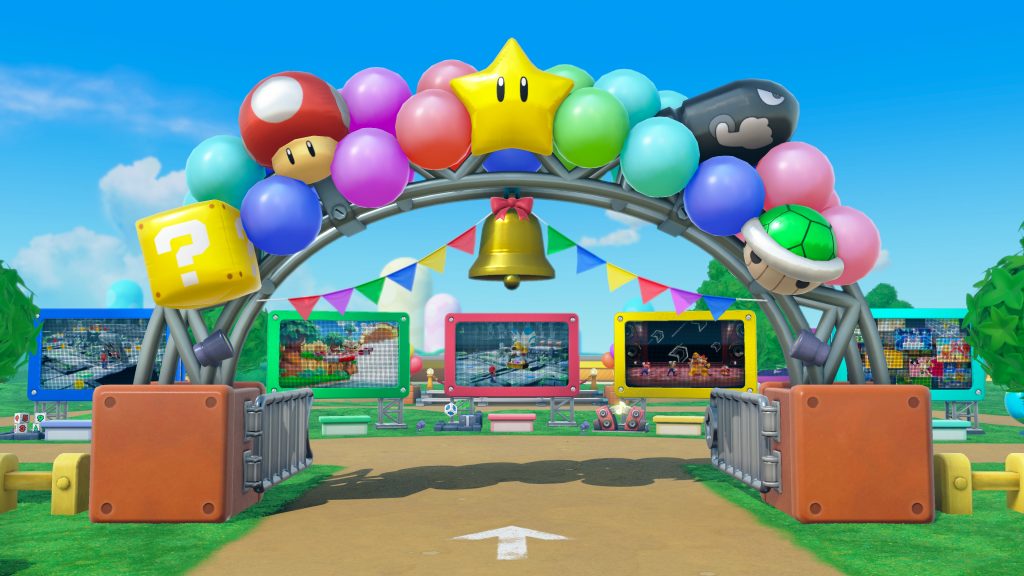
The loose framework is just what the game needs to set itself up, and give you a hub to roam around and pick your modes from in lieu of a traditional menu system. If you’re playing without a full group of four the game will have you recruit CPU characters before you can even choose, trimming down the amount of setup required for longer, fuller fits of festivities.
Something worth noting for the game is that, unlike many other Switch titles, it cannot be played in handheld mode; nor can it be played with anything other than a single Joy-Con. While this makes sense considering just how integral the controller is to the game’s design, it’s still unfortunate that highlighting one of the Switch’s features comes at the expense of another here. What it does it does well though, both on the big screen and if you want to play in tabletop mode.
Once you step into the Party Plaza, you’ll find five distinct modes to play through with a few others to unlock fairly quickly as you go. Front and center is the more classic style of play aptly called Mario Party. By rolling your way through the boards and gathering up the most Stars, you’ll be deemed winner after a predetermined number of turns, with it being the purest and most familiar Mario Party experience since 8.
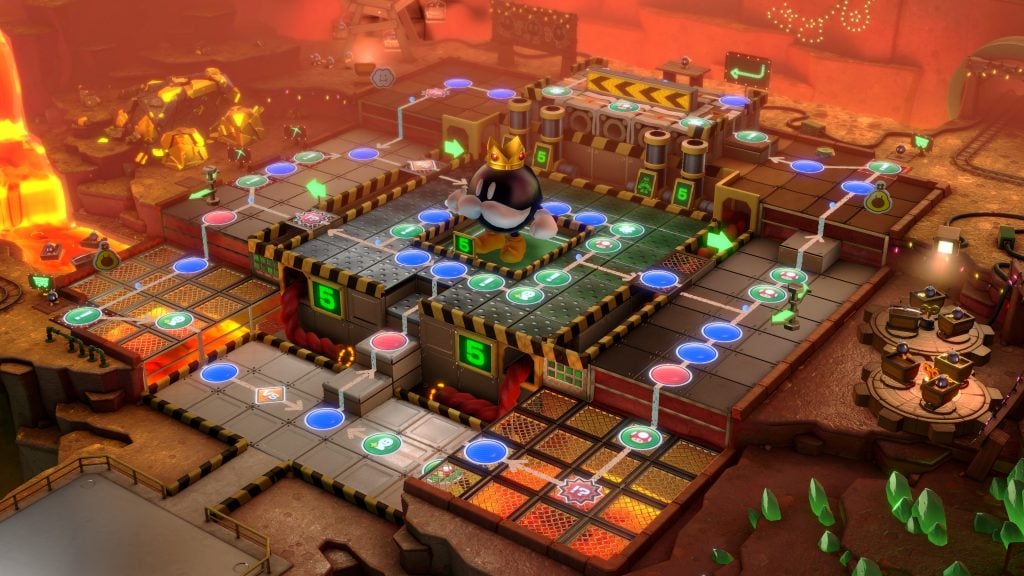
Trying to party like it’s 1999
That familiarity does come with some changes and additions though, and for the most part they work well. Along with the standard one-through-six die, characters now have their own special dice blocks, giving some strategy and variance to who you choose to play as. The Shy Guy die is all fours save for one zero, for example, while Luigi’s is half ones and half high numbers.
This also gives rise to a slightly modified version of the Ally system from Mario Party: Star Rush on 3DS. Certain spaces and items might have you recruit other characters, giving you access to their dice blocks as well as a little boost to your rolls every time. I enjoyed gathering up party pals, but it doesn’t exactly shake things up in this particular mode, for better or worse.
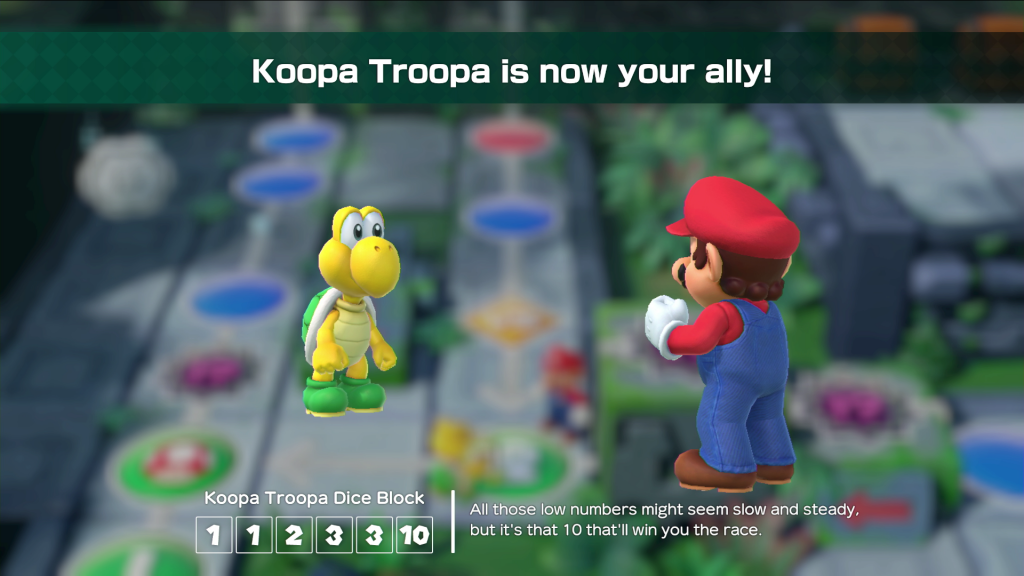
In fact, with only three fairly minimal boards available from the get-go and fewer instances of major reversals of fortune (so long, Chance Time…), this is one of the tamer bashes Mario’s ever held. Still, there’s plenty of fun to be had here with good company even with the less dire stakes at work. That said, a fourth unlockable board is also in the mix and it manages to tweak the usual style in ways akin to some of the GameCube era’s more interesting ideas, like one-way paths and differing Star prices and amounts — and makes for a definite stand out.
If you want a new twist on board based boppin’, Super Mario Party also brings along Partner Party. Also borrowing from Star Rush, it’s a free-roaming board style for teams of two to face off in. Using modified versions of the Mario Party modes boards, it also makes the Ally system a much bigger part of the game by making them more common occurrences and giving you a huge variety of dice to use in a mode where precision is key.
Here you and your teammate share items, combine dice rolls, and have to think about your movements together in order to land on specific Star spaces rather than pass a buyable Star. It encourages communication and strategy, giving it a different flavor of board game style fun that I ended up enjoying more than I thought I would. That said, it is a little trickier to get your head around even if the core of the experience is shared with the more proven party formula.
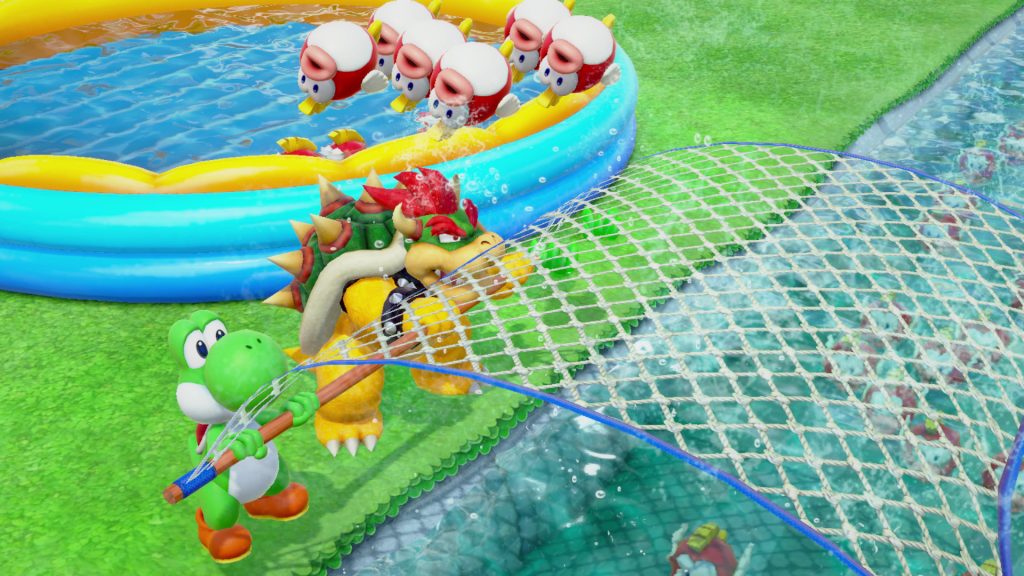
A little luck, a little skill, and a whole lot of fun
Holding up these board games and starring in the remaining modes are the life of any Mario Party: minigames! With over 80 brand new ones they aim to make the most of the Joy-Con. While they don’t reach the heights of the series’ best, Super does an admirable job of making its minigames fun and varied, and they stand as a promising start of a new era of shindigs. More than 1-2-Switch or any other title, this is what Nintendo should be pointing to as a demonstration of the Joy-Con’s capabilities.
It bears mentioning that seemingly just as often as you control these with the stick and buttons, you’ll be using motion controls or relying on HD Rumble. With the Joy-Con being streets ahead of the Wiimote, I actually ended up enjoying these, even if certain games will have you wondering just how you’re supposed shake it to get a last piece of candy out of a jar.
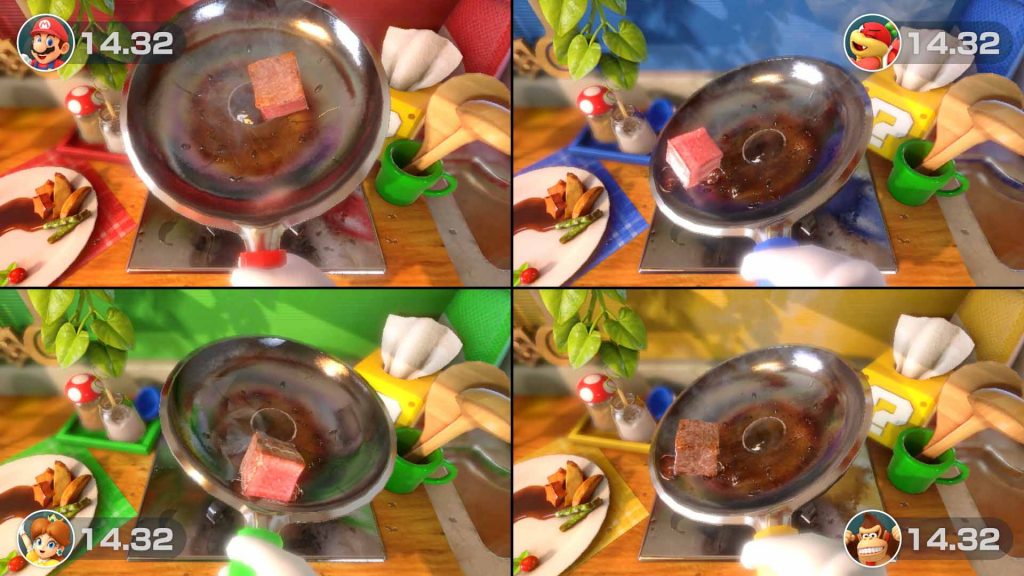
The standard Minigame mode offers up freeplay of the games, some of which need to be discovered through rounds of board gaming before you can do so. Pick and choose your favorites, or play through the new Mariothon minigame tournaments that can be played both locally and for the first time online. Simple in practice, you’ll play through five minigames and gather up points based on performance. Some minigames are tweaked to allow you to play until everyone loses versus play until there’s a winner, leading to occasional bouts of just watching someone else minigame for while.
To be fair, it’s common enough in Mario Party across the series’ entire history, but having that be the case even online leads to both lulls in the competition and perfect opportunities for rage quitters to cut their losses and bail. Mariothon loses out on creativity to fellow ways to play Square Off, where you compete to claim spaces on a grid by winning minigames. With that alone it’s nothing special, but being able to steal squares with smart placement elevates it to something more engaging.
Bringing everything and everyone together
Three more minigame-centric modes round out the game’s events. River Survival mode is a co-op rafting adventure where you and three others row your Joy-Con to head down the branching paths of a riverway. To get to the end before time runs out you’ll have to dodge obstacles and pop balloons to play minigames and win time. This one’s the most fun I had outside of the board game modes, putting the spotlight on full team co-op. That opens the door to new kinds of minigames and leads to a friendly and fun good time down the wild waterway.

Enjoyable as it is, the smaller number of co-op games can lead to some repeat appearances depending on how good you and yours are at steering into the balloons. Again, a problem not unique to this mode but one that’s made more notable with any back-to-back playthroughs for sure. Don’t let that make you pass up on River Survival by any stretch; I’d just recommend jumping around to some other modes before diving back in.
Somewhere where repetition isn’t a problem though is Challenge Road. Requiring that you unlock all the minigames before it’ll open, this is akin to other Mario Party minigame modes that task you with clearing nearly everything the game has to reach the end. That’s 80 minigames in a row, and while that can take a while, I still couldn’t help but push myself to get through at least one full run. Consider that another compliment for the assortment of minigames as a whole in Super Mario Party.
Finally, we come to Sound Stage. This mode localizes a small batch of rhythm based minigames that emphasize motion controls entirely. Depending on your tolerance for rhythm games and waggle, this could either be a fun mode that encourages you to get up and move or a bothersome bump in the road on the way to Super Stardom. Regardless, it plays well and thankfully keeps to itself, save for the minigames being a part of Challenge Road.
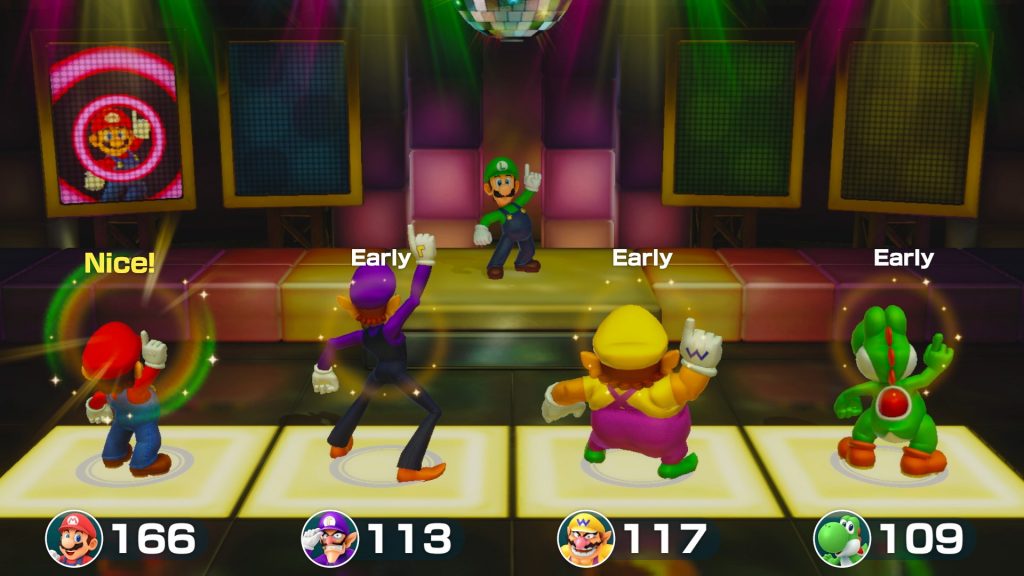
A few party favors before you go
Beyond that, there isn’t much else to Super Mario Party. Toad’s Rec Room gives you a few games that can be played with multiple Switch systems, though they feel less like guests of honor and more like a guest desperately trying to chat you up about their cool new idea by the punch bowl. Fun, sure, but they’re out of the way from the rest of things, and they require a whole separate system and second copy of the game to play in the first place.
One thing that stood out throughout my time with the game was just how great it looks. It doesn’t reach the heights of something like Super Mario Odyssey, but Super carries an inherent charm and cuteness in all of its corners. Maybe it’s Toad and Toadette’s endless enthusiasm, the way the game encourages you to high five teammates, or just that this is just the power of the Switch at work — whatever the reason, it makes for the perfect icing on the cake.
Super Mario Party marks the beginning of a revival to the series that was long overdue. Unquestionably charming and consisting of a fresh selection of minigames made with the Joy-Con in mind, it breathes some fresh air into what was a deflated affair. The boards are smaller and the thrills are gone, but what’s new here is a promising look at what could be a new chapter of multiplayer fun from Nintendo. Things like Ally recruitment, co-op minigames, and the first forays into online play manage to feel less like gimmicks or one-off features and instead show promise as natural progressions for the series. It’s not about to replace the N64 days, but this is still a Switch soirée worth RSVPing for.
Leave a Comment
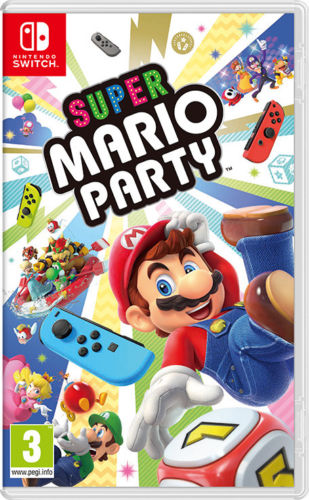
System: Nintendo Switch
Release date: October 5, 2018
Category: Party
Publisher: Nintendo
Developers: Nintendo
